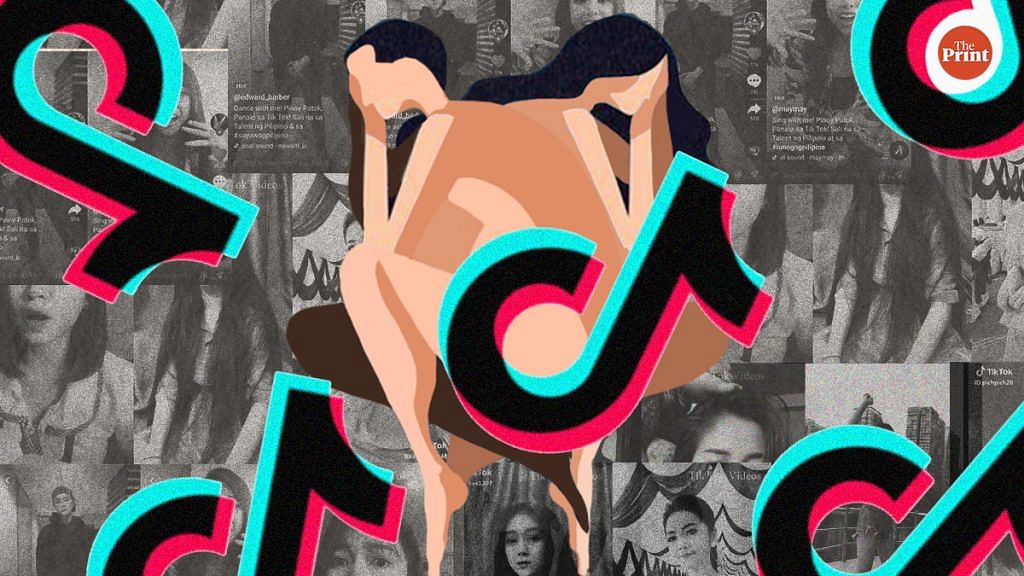TikTok, the 15-second video sharing app, has come under the scanner for ‘spreading pornography’. The Madras High Court recently asked the Centre to ban the popular Chinese app for encouraging pornographic content.
ThePrint asks: Can we hold TikTok responsible for the spread of pornography in India?
If Snapchat can grow out of its sexting app reputation with policy changes, so can TikTok
Web editor, ThePrint
Responsibility in video sharing apps like TikTok and Snapchat is placed at two levels – a personal level where the user is vigilant of the video he or she is uploading, and the company level, where the platform has to be vigilant about videos being uploaded.
Personal vigilantism about whether or not the videos uploaded by you can be vulnerable to pornography comes only with awareness. This realisation comes about if parents, schools and social groups are pro-active and alert children early in life about the risky side of the internet. An aware child or adult is always less likely to fall prey.
Accountability is another form of making TikTok responsible for its content. AI detecting content of pornographic nature can also help.
While it may seem like TikTok’s user interface is aiding users to upload pornographic content, let us not forget that these negative aspects of video apps don’t last long and the key to this lies in the development of the app over time. One prime example of this is Snapchat that initially was notorious for allowing people to send nudes, but soon grew out of that phase and with stricter privacy policies. Its editorial regulation on its ‘Discover’ channels requires publishers to not post nude or semi-nude photos. TikTok may dodge this form of policy adjustment for now, but it will eventually have to be held responsible as it grows globally.
Too early to hold TikTok responsible for spread of pornography in India
Reporter, ThePrint
The Madras High Court has asked the Centre to ban the TikTok app for spreading pornography. But it will too early to hold TikTok responsible for the spread of pornography in India. Pornsites like PornHub, X-Videos rule the market of pornographic content. In fact, PornHub’s survey once revealed that India was among its biggest users.
Further, vulgar videos shot on mobile phones are also in demand and so are the terrifying ‘rape videos’. Voyeurism has increased after small cameras and cheap mobile phones have occupied the market.
TikTok looks feeble in comparison to these formidable websites and applications. Rather than pornography, TikTok serves the purpose of having fun in your own body and voice, wherever you are. Yes, if there is a camera and internet on the phone, there is a possibility of pornographic content being generated. Still, it will be too early to hold TikTok responsible for all of it.
Most importantly, why fear pornography? The government can encourage healthy discussion and dissemination of knowledge about sex through these apps.
Also read: Coy and in ‘ghoonghats’, these women are taking over Youtube, TikTok with their rural lives
Such moves undermine people’s right to create and operate legitimate business enterprises
Journalist, ThePrint
As technology has evolved, the collective IQ of our society has degenerated. Nothing exemplifies it better than TikTok (and maybe the selfie-obsessed youth present everywhere).
However, holding TikTok responsible for the spread of pornography is nothing but false equivalence. Just because something is risqué doesn’t imply that it can be classified as porn. Such a suggestion itself represents a case of cultural degeneration. It not only curtails people’s freedom to express themselves, but also legitimises the presence of self-proclaimed cultural vigilantes. In fact, it also undermines people’s right to create and operate legitimate business enterprises.
In the era of the internet, pornography is a reality. It’s not as if it suddenly emerged on the scene after TikTok. The sooner we accept that some things should only be regulated and not suppressed, the better off we will be.
Businesses are rational entities that while valuing profit-maximisation prefer to operate within the confines of the law. If it has been observed that a platform like TikTok may expose very young children to indecent content, then mechanisms should be developed in collaboration with the company to guard against such possibilities.
Making sweeping generalisations and picking up moral cudgels is not the answer.
Child pornography is circulated on YouTube, WhatsApp & porn sites. Will be silly to hold just TikTok guilty
Reporter, ThePrint
We cannot hold one single medium like TikTok responsible for the spread of pornography in India, because it is not the only medium through which objectionable content is disseminated. Child pornography is circulated on WhatsApp, teenagers share nude selfies on Instagram, there are ‘sexual’ videos on YouTube, porn websites like PornHub and xHamster.
It will be extremely silly to hold one app responsible for it.
The second silly thing to happen is that on 3 April Madras High Court asked the Centre to ban TikTok saying it encourages pornography.
I wonder how many of these policy and lawmakers have used TikTok personally before coming to such a decision. I have seen a few risqué dance moves and revealing outfits, but have not seen anything that qualifies as pornographic. I’m sure there are unfortunate instances where TikTok has been misused by an individual as reported in the media, but objectionable content is a problem most platforms deal with – not just TikTok.
Instead of calling for bans (which is a slippery slope leading to muzzling freedom of speech), let’s set up effective regulations and encourage responsible use of the internet and these apps — because TikTok is but a tool in the hands of a human user wielding it.
